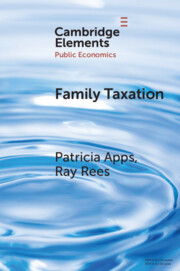Refine search
Actions for selected content:
89 results
Gendered effects of rainfall variability in Burkina Faso: an economy-wide CGE model-based analysis
-
- Journal:
- Environment and Development Economics , First View
- Published online by Cambridge University Press:
- 22 September 2025, pp. 1-20
-
- Article
-
- You have access
- Open access
- HTML
- Export citation
To work or not to work: Women’s Employment in the Slums of Kolkata, India
- Part of
-
- Journal:
- The Economic and Labour Relations Review ,
- Published online by Cambridge University Press:
- 01 September 2025, pp. 1-22
-
- Article
- Export citation
Work-related decision-making and economic well-being among married women in India
-
- Journal:
- The Economic and Labour Relations Review ,
- Published online by Cambridge University Press:
- 20 August 2025, pp. 1-22
-
- Article
-
- You have access
- Open access
- HTML
- Export citation
Can gender diversity prevent risky choice shifts? The effect of gender composition on group decisions under risk
-
- Journal:
- Experimental Economics ,
- Published online by Cambridge University Press:
- 15 August 2025, pp. 1-22
-
- Article
-
- You have access
- Open access
- HTML
- Export citation
Are men less generous to a smarter woman? Evidence from a dictator game experiment
-
- Journal:
- Journal of the Economic Science Association ,
- Published online by Cambridge University Press:
- 18 July 2025, pp. 1-14
-
- Article
-
- You have access
- Open access
- HTML
- Export citation
Heterogeneous effects of economic freedom on human capital in developing countries
-
- Journal:
- Journal of Institutional Economics / Volume 21 / 2025
- Published online by Cambridge University Press:
- 16 May 2025, e18
-
- Article
-
- You have access
- Open access
- HTML
- Export citation
Towards a gendered and green job guarantee programme in India
- Part of
-
- Journal:
- The Economic and Labour Relations Review ,
- Published online by Cambridge University Press:
- 14 May 2025, pp. 1-14
-
- Article
- Export citation
Gender segregation and women’s ‘ancillary’ occupations: The case of health care receptionists
- Part of
-
- Journal:
- The Economic and Labour Relations Review ,
- Published online by Cambridge University Press:
- 25 April 2025, pp. 1-19
-
- Article
-
- You have access
- Open access
- HTML
- Export citation

Family Taxation
-
- Published online:
- 21 April 2025
- Print publication:
- 22 May 2025
-
- Element
- Export citation
Do social comparisons motivate workers? A field experiment on relative earnings, labor supply and the inhibitory effect of pay inequality
-
- Journal:
- Experimental Economics / Volume 28 / Issue 1 / January 2025
- Published online by Cambridge University Press:
- 10 April 2025, pp. 155-180
-
- Article
-
- You have access
- Open access
- HTML
- Export citation
Gender differences in advice giving
-
- Journal:
- Experimental Economics / Volume 27 / Issue 5 / November 2024
- Published online by Cambridge University Press:
- 02 April 2025, pp. 1068-1105
-
- Article
- Export citation
Gender differences in the dictator experiment: evidence from the matrilineal Mosuo and the patriarchal Yi
-
- Journal:
- Experimental Economics / Volume 18 / Issue 2 / June 2015
- Published online by Cambridge University Press:
- 14 March 2025, pp. 302-313
-
- Article
- Export citation
What if women earned more than their spouses? An experimental investigation of work-division in couples
-
- Journal:
- Experimental Economics / Volume 21 / Issue 1 / March 2018
- Published online by Cambridge University Press:
- 14 March 2025, pp. 50-71
-
- Article
- Export citation
Room composition effects on risk taking by gender
-
- Journal:
- Experimental Economics / Volume 23 / Issue 3 / September 2020
- Published online by Cambridge University Press:
- 14 March 2025, pp. 895-911
-
- Article
- Export citation
The role of cognitive ability and personality traits for men and women in gift exchange outcomes
-
- Journal:
- Experimental Economics / Volume 21 / Issue 3 / September 2018
- Published online by Cambridge University Press:
- 14 March 2025, pp. 650-672
-
- Article
- Export citation
Gender preference gaps and voting for redistribution
-
- Journal:
- Experimental Economics / Volume 25 / Issue 3 / June 2022
- Published online by Cambridge University Press:
- 14 March 2025, pp. 845-875
-
- Article
-
- You have access
- Open access
- HTML
- Export citation
On the cultural basis of gender differences in negotiation
-
- Journal:
- Experimental Economics / Volume 21 / Issue 4 / December 2018
- Published online by Cambridge University Press:
- 14 March 2025, pp. 757-778
-
- Article
- Export citation
Gender and competition in adolescence: task matters
-
- Journal:
- Experimental Economics / Volume 17 / Issue 1 / March 2014
- Published online by Cambridge University Press:
- 14 March 2025, pp. 154-172
-
- Article
- Export citation
Pricing competition: a new laboratory measure of gender differences in the willingness to compete
-
- Journal:
- Experimental Economics / Volume 19 / Issue 3 / September 2016
- Published online by Cambridge University Press:
- 14 March 2025, pp. 642-662
-
- Article
- Export citation
Under- versus overconfidence: an experiment on how others perceive a biased self-assessment
-
- Journal:
- Experimental Economics / Volume 19 / Issue 1 / March 2016
- Published online by Cambridge University Press:
- 14 March 2025, pp. 218-239
-
- Article
- Export citation
